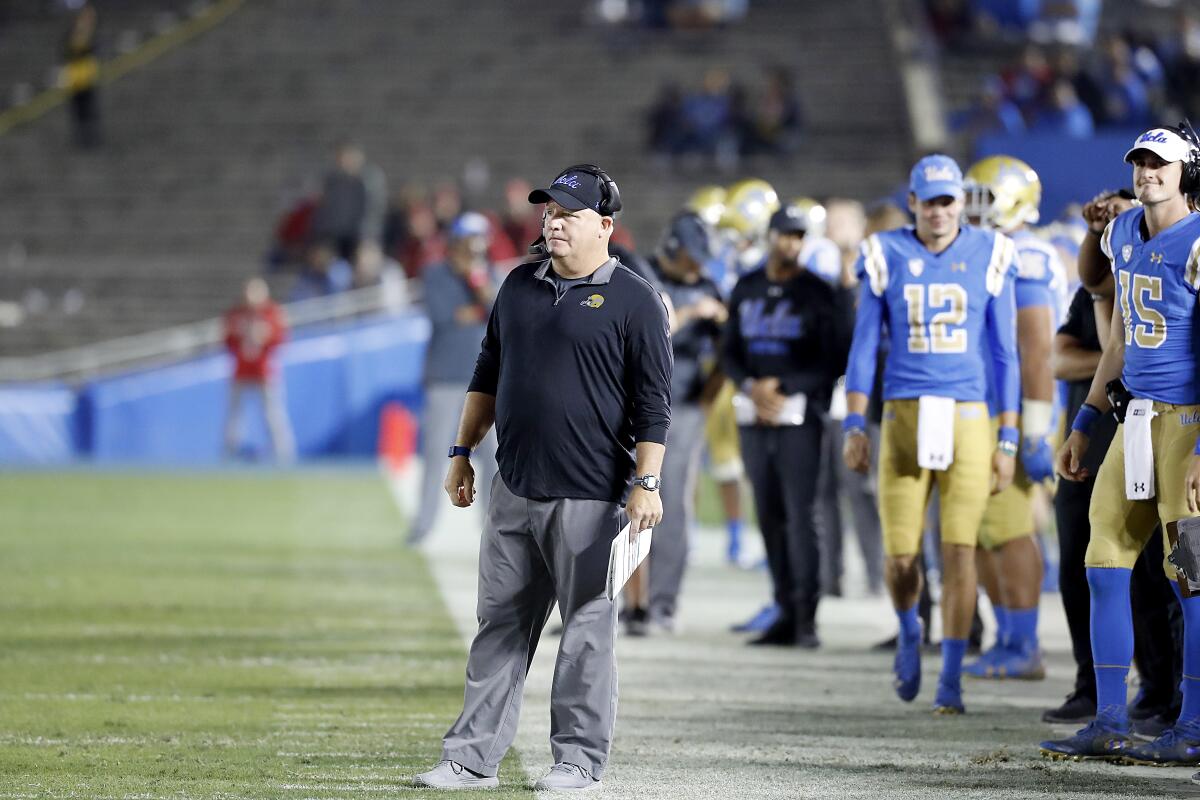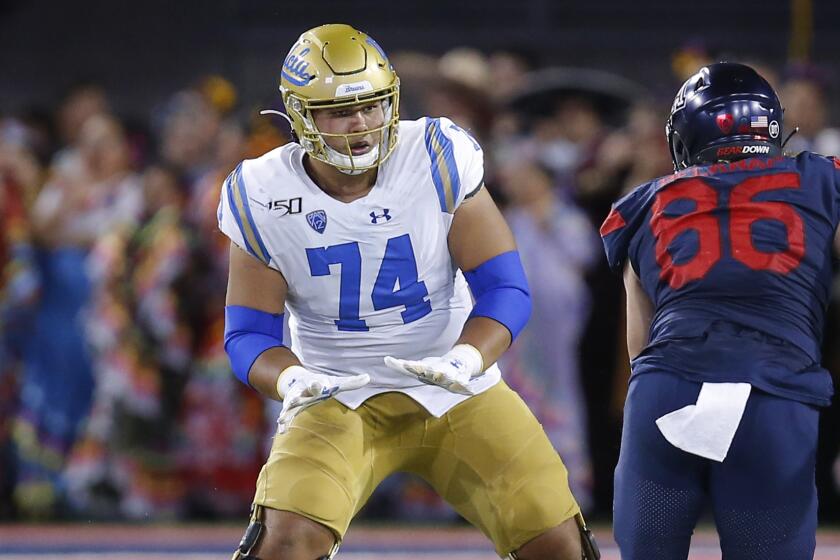UCLA is struggling on the football field and in recruiting

- Share via
Chip Kelly sat in the Orange County high school classroom and made his pitch for the trio of prospects.
“He goes, ‘I want these kids bad,’ ” Corona del Mar football coach Dan O’Shea recalled of the 90-minute conversation with his UCLA counterpart. “ ‘They’re the type of kids I’m looking for; they’d be great fits for the program.’ ”
O’Shea could only nod in agreement. Tight end Mark Redman, quarterback Ethan Garbers and wide receiver John Humphreys were all 4.0 students at one of the best academic high schools in California. They were also incredibly gifted football players, ranked among the top 10 in the nation at their positions.
Landing one of the players would have been a recruiting coup for the talent-starved Bruins, and two or three a bonanza.
They got none.
While Humphreys committed to Stanford, Garbers and Redman pledged to attend Washington.
It was another swing-and-miss showing amid an ongoing series of strikeouts for UCLA’s recruiting. The Bruins brought in a class ranked No. 40 nationally by 247Sports last season and are on pace to bring in one ranked No. 76 for 2020 with two months left before the early signing period that most players are using to make their commitments binding.
UCLA’s young offensive line has been engulfed in a trial by fire this season, but the unit has seen some improvement in recent games.
The lagging results can be attributed to several factors, according to high school coaches, players and recruiting experts, including a team that’s off to an abysmal start under Kelly, a coaching staff that is being outhustled by its competitors and an evaluation of recruits that may be overly discriminating.
UCLA had pursued Redman fairly early, O’Shea said, but was several months behind other suitors on Garbers and Humphreys, even though both players were widely coveted prospects with excellent grades. O’Shea said the players were “tickled pink” to be offered by UCLA but had already developed unbreakable bonds with the schools they ultimately chose.
Why weren’t the Bruins in the mix earlier?
“They’re more selective,” O’Shea said of UCLA’s recruiting approach. “Oregon is offering 500 guys and [UCLA is] offering 50 guys.”
Oregon is also getting more guys. The Ducks have 20 players committed in their current class — twice as many as the Bruins — including eight four-star players on the widely used five-star scale. UCLA has one four-star player, quarterback Parker McQuarrie from St. Paul’s School in Concord, N.H.
While statistics show that the roster of every College Football Playoff participant has been dotted heavily with four- and five-star players, Kelly appears intent on a different sort of star chasing.
“A kid may be a five-star,” Kelly said Wednesday, “but he’s not a five-star character and he’s not a five-star academic; he’s a five-star but that doesn’t mean that he fits.”
Kelly noted that UCLA’s academic requirements differ from many of its Pac-12 Conference counterparts and that he was able to win big at Oregon without a highly ranked recruiting class, though three of his four classes ranked No. 14 or better nationally.
Kelly and his staff pride themselves on a thorough evaluation of prospects before commencing their pursuit, starting with Ethan Young, the new director of player personnel.
“I could say, ‘Hey, Ethan, a buddy of mine told me about a 6-foot safety in Tennessee,’ ” Kelly said, “and he knows who the kid is already and has already looked at the film of him.”
The legwork has spared coaches wasted effort on players who aren’t good fits. The issue has been that not enough of those good fits have decided to become Bruins.
UCLA appeared to be leading for a slew of offensive linemen over the summer before they all chose to go elsewhere. Jeffrey Persi chose Michigan, Myles Murao picked Washington and Kilian Zierer opted for Auburn.
“All three of those were guys we thought were going to UCLA but for various reasons, they just lost them,” said Greg Biggins, a national recruiting analyst for 247Sports. “Any one of those guys would have been huge for them.”
Kendall Ellis enjoyed intense, yet fleeting, fame as an NCAA track champion. A new California law, formerly SB-206, would have also allowed her to cash in.
Kelly’s early recruiting stumbles, combined with his team’s 4-13 record in his first 1½ seasons, have presented the coach with a worrisome conundrum: Can the Bruins acquire the talent needed for wins if they can’t get the wins needed to attract the talent?
“The problem is,” Biggins said, “a lot of kids, for the first time in maybe a long time, they’re kind of taking a wait-and-see approach with UCLA whereas before, it always kind of felt like they’re going to get kids no matter what. Now it almost feels like they want to see UCLA improve on the field a little bit and so that’s not happening.”
John Humphrey, a three-star cornerback from Muir High in Pasadena who has committed to the Bruins, said he viewed the team’s struggles as an opportunity to make an immediate impact but also understood why others might be hesitant about a program that hasn’t had a winning season since 2015.
“I mean, it depends on how the people look at it,” Humphrey said, “if they want to come in and help rebuild the program or if they want to go to a program that’s already on top.”
The Bruins remain in the running for a handful of top prospects, including receivers Gary Bryant Jr. (Corona Centennial) and Logan Loya (Bellflower St. John Bosco), putting them in position to nudge their class toward respectability. A second consecutive low-rated class could leave Kelly with a depleted roster that no amount of scheming or personnel development could overcome.
“You can have a one-year hit,” Biggins said, “but you can’t go back-to-back classes without bringing in some pretty elite talent. … They need to turn it around and either start to win or completely kind of change their recruiting approach and almost be like an Oregon; they’re going to have to out-recruit for players and right now, they’re not really doing that.”
Some of the difficulties may lie in a coaching staff that skews older and is not known as dogged recruiters, Biggins said. Quarterbacks coach Dana Bible is 65, defensive coordinator Jerry Azzinaro is 61, inside linebackers coach Don Pellum is 57 and defensive backs coach Paul Rhoads is 52.
Biggins said UCLA coaches have become more aggressive in their pursuit during this recruiting cycle and are generally going after a higher caliber of prospects than they did last year, when their class also included only one four-star player in left tackle Sean Rhyan.
Ultimately, Kelly said, his recruiting results will hinge on finding enough players suited to his system.
“There are teams that are highly successful that don’t have highly recruited kids,” Kelly said, “and there are other teams that are really successful because they have highly recruited kids, but I think you have to have a plan for what you run schematically that those guys fit in what you do.”
More to Read
Go beyond the scoreboard
Get the latest on L.A.'s teams in the daily Sports Report newsletter.
You may occasionally receive promotional content from the Los Angeles Times.








